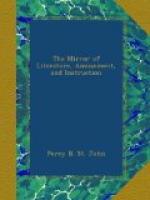The following particulars were communicated to the Gentleman’s Magazine of this month by a witness to a recent bull-fight in the city of Lisbon. Speaking without reference to its humane character or moral tendency, the writer remarks that no spectacle in the world can be compared, for interest and effect, to a Spanish bull-fight, every part of which is distinguished for striking parade or alarming danger.
The grand sweep of the amphitheatre in Cadiz, Seville, or Madrid, crowded with a gay and variegated mass of eager and shouting spectators, and garnished at distances with boxes for the judges, the court, or the music—the immense area in which the combats take place, occupied with the picadors in silk jackets, on horses richly caparisoned, and with the light skipping and elastic bandarilleros, carrying their gaudy silk flags to provoke the rage and to elude the attack of the bull, form of themselves a fine sight before the combat begins. When the door of the den which encloses the bull is opened, and the noble animal bursts in wildly upon this, to him, novel scene—his eyes glaring with fury—when he makes a trot or a gallop round the ring, receiving from each horseman as he passes a prick from a lance, which enrages him still more—when, meditating vengeance, he rushes on his adversaries, and scatters both horsemen and bandarilleros, by his onset, ripping up and casting the horses on the ground, and causing the bandarilleros to leap over the railing among the spectators—or when, after a defeated effort or a successful attack, he stands majestically in the middle of the area, scraping up the sand with his hoof, foaming at the mouth, and quivering in every fibre with rage, agony, or indignation, looking towards his adversaries, and meditating a fatal rush—the sight combines every element of interest and agitation which can be found in contempt of danger, in surprising boldness, and great animal force intensely excited. The horns of the Spanish bull are always sharp, and never covered. An animal of sufficient power and spirit to command popular applause frequently kills five or six horses, the riders taking care to fall over on the side most distant from the enemy, and being instantly relieved from their perilous situation by the bandarilleros, who attract his attention: and the bull himself is always killed in the ring by the matador, who enters in on foot with his bright flag in the left hand, and his sword in the right, and who, standing before the enraged animal waiting the favourable moment when he bends his head to toss him on his horns, plunges his sword into his neck or spine in such a fatal manner that he frequently falls instantaneously as if struck by lightning. This last operation is as dangerous as it is dexterous. At the moment in which the matador hits the bull, the pointed horn must be within an inch or two of his heart, and if he were to fail he must himself be the victim. When he succeeds in levelling to the ground




